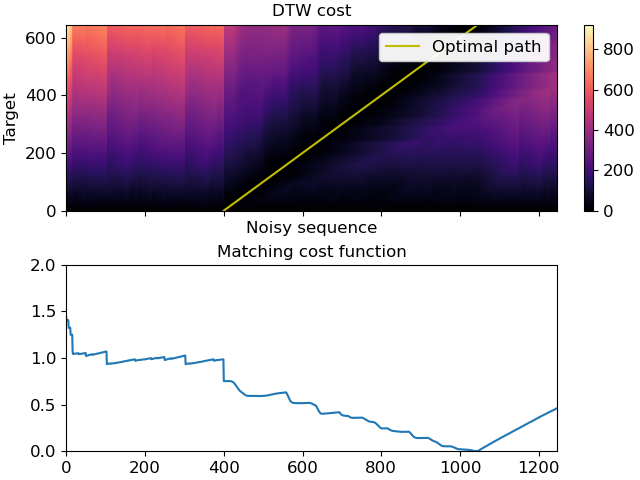Caution
You're reading the documentation for a development version. For the latest released version, please have a look at 0.11.0.
librosa.sequence.dtw
- librosa.sequence.dtw(X=None, Y=None, *, C=None, metric='euclidean', step_sizes_sigma=None, weights_add=None, weights_mul=None, subseq=False, backtrack=True, global_constraints=False, band_rad=0.25, return_steps=False)[source]
Dynamic time warping (DTW).
This function performs a DTW and path backtracking on two sequences. We follow the nomenclature and algorithmic approach as described in [1].
- Parameters:
- Xnp.ndarray [shape=(…, K, N)]
audio feature matrix (e.g., chroma features)
If
Xhas more than two dimensions (e.g., for multi-channel inputs), all leading dimensions are used when computing distance toY.- Ynp.ndarray [shape=(…, K, M)]
audio feature matrix (e.g., chroma features)
- Cnp.ndarray [shape=(N, M)]
Precomputed distance matrix. If supplied, X and Y must not be supplied and
metricwill be ignored.- metricstr
Identifier for the cost-function as documented in scipy.spatial.distance.cdist()
- step_sizes_sigmanp.ndarray [shape=[n, 2]]
Specifies allowed step sizes as used by the DTW.
- weights_addnp.ndarray [shape=[n, ]]
Additive weights to penalize certain step sizes.
- weights_mulnp.ndarray [shape=[n, ]]
Multiplicative weights to penalize certain step sizes.
- subseqbool
Enable subsequence DTW, e.g., for retrieval tasks.
- backtrackbool
Enable backtracking in accumulated cost matrix.
- global_constraintsbool
Applies global constraints to the cost matrix
C(Sakoe-Chiba band).- band_radfloat
The Sakoe-Chiba band radius (1/2 of the width) will be
int(radius*min(C.shape)).- return_stepsbool
If true, the function returns
steps, the step matrix, containing the indices of the used steps from the cost accumulation step.
- Returns:
- Dnp.ndarray [shape=(N, M)]
accumulated cost matrix. The value at the final index position
D[-1, -1]is the total alignment cost.- wpnp.ndarray [shape=(L, 2)]
Warping path with index pairs. Each row of the array contains an index pair (n, m). Only returned when
backtrackis True. Note that the lengthLof the warping path need not match the lengths of the input data, depending on thestep_sizes_sigmavalues andsubseq.- stepsnp.ndarray [shape=(N, M)]
Step matrix, containing the indices of the used steps from the cost accumulation step. Only returned when
return_stepsis True.
- Raises:
- ParameterError
If you are doing diagonal matching and Y is shorter than X or if an incompatible combination of X, Y, and C are supplied.
If your input dimensions are incompatible.
If the cost matrix has NaN values.
Examples
>>> import numpy as np >>> import matplotlib.pyplot as plt >>> y, sr = librosa.load(librosa.ex('brahms'), offset=10, duration=15) >>> X = librosa.feature.chroma_cens(y=y, sr=sr) >>> noise = np.random.rand(X.shape[0], 200) >>> Y = np.concatenate((noise, noise, X, noise), axis=1) >>> D, wp = librosa.sequence.dtw(X, Y, subseq=True) >>> fig, ax = plt.subplots(nrows=2, sharex=True) >>> img = librosa.display.specshow(D, x_axis='frames', y_axis='frames', ... ax=ax[0]) >>> ax[0].set(title='DTW cost', xlabel='Noisy sequence', ylabel='Target') >>> ax[0].plot(wp[:, 1], wp[:, 0], label='Optimal path', color='y') >>> ax[0].legend() >>> fig.colorbar(img, ax=ax[0]) >>> ax[1].plot(D[-1, :] / wp.shape[0]) >>> ax[1].set(xlim=[0, Y.shape[1]], ylim=[0, 2], ... title='Matching cost function')
